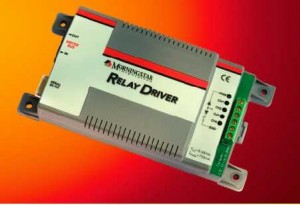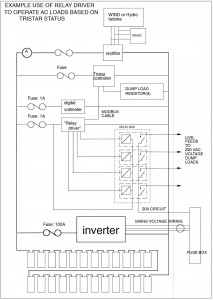PWM controllers are ideal for optimising the charge rate of your battery. But the energy they divert is often wasted in a resistance heater in the battery shed. OK so this may only be a rare event. And it does no harm. But some systems produce a lot of surplus energy that can be harnessed to make life better and reduce fuel consumption in the home.
One way to do this is to connect the Tristar (or C-40) PWM controller to a custom made water heater, and I plan to make a page about this option soon. It’s what I do, but it’s not the easiest for a lot of people. So I am going to mention the Relay Driver.
There are a lot of devices that will turn relays on and off at set voltages so as to manage loads on the system and keep the battery charged at the same time. I mentioned my own homebrew circuit on another page. If you have an Outback FX inverter you will a have built-in auxiliary relay that you can use. Or you can buy a ‘voltage controlled switch‘ (made by Solar Converters – I sell these for £75). Or one of the many ‘charge controllers’ that are basically voltage-controlled relays too.
All of these devices will turn a load on when the voltage reaches the desired level of optimum battery charging, and will turn it off after a delay or at a lower voltage ‘set-point’. So what’s special about the Relay driver? The Relay Driver has four outputs, each of which can be programmed to work in a different way based not only on supply voltage, but also on sensing the condition of other items such as PWM dump loads, and the internal state of an adjacent Tristar controller (via a dedicated coms link). So for example you can wait until the Tristar has been dumping at more than 25% of its capacity for a total of 15 minutes and then turn on a water heater that works on AC via the inverter. If you do not need hot water then the thermostat or manual switch on the heater will defeat this and the normal charge control will proceed via the Tristar.
The Relay Driver has four outputs, each of which can be programmed to work in a different way based not only on supply voltage, but also on sensing the condition of other items such as PWM dump loads, and the internal state of an adjacent Tristar controller (via a dedicated coms link). So for example you can wait until the Tristar has been dumping at more than 25% of its capacity for a total of 15 minutes and then turn on a water heater that works on AC via the inverter. If you do not need hot water then the thermostat or manual switch on the heater will defeat this and the normal charge control will proceed via the Tristar. The programing of the Relay Driver requires a Windows based computer with an RS232 lead (an aging laptop is perfect) running thecorrect software.
The programing of the Relay Driver requires a Windows based computer with an RS232 lead (an aging laptop is perfect) running thecorrect software.
Buy a Tristar controller or a Relay Driver
Charge controllers (relay type and PWM type)


HI, I operate a nature reserve in the cloud forest of Costa Rica, I have run off two micro hydro systems for the past 7 & 10 years. The grid finally arrived and we have put most of our electrical systems on the grid. I have always used 40 gallon water heaters as my dump, I would like to continue heating water with the hydro. Can I run directly from the turbine to the water heater without using my inverter or batteries? And is there a way to heat multiple tanks as one hits temperature jump to a back up. Thank you for your help.
Hi Tom,
Yes you can work with hydro power direct and I have done that. I’d need details of generator type to help with that. Induction gens need capacitors. Or it might be prudent to keep your battery system as a backup in case if grid outages?
Cheers
Hugh
@antonio- this generators are good for nothing. They all 1500rpm.
At 1,5-2m long blades you can not reach more than 600rpm.
@autor- did you try other approaches to heaters?
From few years we deliver(poland is very cold country) controllers with rather small histeresis and directed by specialized computer-and we never have problems with cut off inwerters because of heaters load. This could be posiible when you use 12V systems because histeresis is very small then(cut in of heater should be around 14,7V, cut out 14,4V) and any delay could cause battery reach 11V and inverter should cut off.
But when you work with 48V it is no big danger you plug heater in on 57V(cascade is better) and out at 55 and as far as voltage which disconnects inverter is 44V- you always have enough energy in batteries.
And separate electrically charging and discharging buses of batteries- this helps when any failure heppens- your heaters wouldn’t dicharge your batteries- and cost is 2-3USD(few diods). I can make electric scheme of it but I don’t know how to post it here.
hi Arek,
If you want me to display a picture of a diagram here then just send it to me at [email protected] and I will put it in your message for you.
hugh
Is it possible what this site?
http://generatory-magnetyczne.pl/
Hi, I bought the book in Spanish, I’m from Spain, I could better explain the operation of the heater, where do you connect? Thank you. I’m new and I will start with the turbine
You can connect a heater to the battery so as to divert or dump current into the heater. This controls the current into the battery. Or you can conect the heater to an inverter so as to run it using AC. AGain this will divert current that would have gone into the battery. it’s even possible to connect a heater to the wind turbine (or water turbine) directly. In some cases this can avoid discharging the battery (even briefly) but it may cause the turbine to stall and become less productive so you get less heat.
hola ,he comprado el libro en español,soy de españa,me podria explicar mejor el funcionamiento del calentador ,¿a donde se conecta? gracias.
You know how difficult it is for things to come on the market. At the moment, i have no aspirations to do that but, I’ll program PICs for people and give them a schematic if they’re interested.
At the moment, I’m concentrating on DC so, inverter cut-outs are not in my field of vision. True, a heavy heating element could, momentarily, knock the voltage down and, if an inverter had to service something like a motor-starting event, it could cut out.
An old Wincharger brochure that I once saw had quite a bit of wisdom. It showed a woman (in those 1940’s sexist times !!! ) doing “her” vacuuming with the note that managing the load by doing all of this stuff, while it was windy, improved the performance of a wind system. Taking that idea and automating it could help.
As an aside, I have read that SunDanzer has experimented with solar direct, in the operation of its fridges. I forget the details but I think they used a phase change material to store cold. However, if the “off” intervals, corresponding to zero input energy, are of short duration, then maintaining fridge-like temperatures could be done simply, by placing a few liters of water inside the cabinet. With a combined solar/wind installation, the probability of zero input energy lasting more than 12 hours, or so, might be fairly low. So, maybe fridge operation could also be automated to avoid drawing down the batteries.
I killed a nice set of batteries once. Today, through improved end-use efficiency and load management, I believe that we can avoid such scenarios.
Anyway, my thinking is that, when a time delay is used, it should probably be adapted to the time it takes whatever it controls to complete a cycle. So, water pumps (with large pressure tanks) are a natural…maybe 5 minutes. Air compressors, depending on the storage capacity, might require a comparable time. After these needs are serviced, lower priority items, like heating elements, can be serviced.
All good stuff David, thanks. When is your $10 relay driver coming on the market? I agree that a time delay can be a better choice than a voltage threshold in many cases. The only danger with a small battery is that using a time delay creates such a large voltage swing that the inverter cuts out on over- or under-voltage.
This is a very important topic for off-grid, battery-based systems, whether PV or wind. I’ve been working with relay drivers and with what I’d call “floating” regulators, for several years now. A PIC-based relay driver is pretty simple to build and costs about $10 CAD. I have abandoned the notion of hysteresis (an “on” high voltage and an “off” low voltage) in favour of using an on voltage and a timed interval that would turn the load off. This makes the switch independent of battery size. (small batteries will have greater voltage swings, when a dump load is attached, than a system with a large battery). Of course, once the PIC turns off the load it would re-evaluate the situation and decide whether to turn it back on, or not. So, the load could be large or small and, if it already has its own control switch -for example, a pressure switch on a water pump- that could overide the voltage switch.
To secure improved system efficiency, it is also possible to use a moderate voltage like 26 volts on a 24 volt system that would turn on a water pump. This could guarantee that the water pump, at least, would only operate when the system is charging. Doing this would insure that the water pump could only run when it would take current directly from the generator giving several percent of improvement in efficiency. Of course, a large storage vessel would be needed as well as a manual override switch. I’d share plans for such a PIC-based switch with anyone who is interested.
BTW…it’s a lot easier to adjust the turn-on voltage with a potentiometer than with an RS232 connection.
Hi David,
I am looking for a circuit that will sense battery voltage and as the battery goes down to 10.8 v, it should switch (using relay) the load from inverter to the mains grid supply. It should do the other way as well, i.e. as the battery charges to 12 V, it should switch the load from mains grid supply to inverter output. Do you know any such circuit?
hi Mandar,
The relay driver would be ideal for this. I recommend using a higher voltage though. Go to using mains at 11.5 and then revert to battery after it has some charge in it say 13.5 volts. Remember that a battery is expensive and will not last very long if you discharge it to 10.8 volts. It’s a better plan to try to keep it well charged as much as you can.
You could also use this circuit on my old web site for the same job if you can solder it together. http://www.scoraigwind.com/circuits/chargecontrol.htm
have fun
Hugh
very nice site thanks for sharing